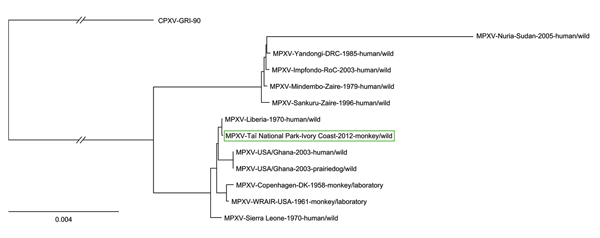Volume 20, Number 6—June 2014
Dispatch
Fatal Monkeypox in Wild-Living Sooty Mangabey, Côte d’Ivoire, 2012
Figure 1

Figure 1. Phylogenetic position of the MPXV-TNP isolate (framed in green) from a wild-living sooty mangabey (Cercocebus atys), March 2012, within the West African cladeMPXV-TNP is closely related to the strain isolated from a human in Liberia in 1970Calculated with MrBayes (with gaps) as binary model (http://mrbayes.csit.fsu.edu)MPXV, monkeypox virus; TNP, Taï National Park (Côte d’Ivoire)Scale bar indicates nucleotide substitutions per site.
Page created: May 16, 2014
Page updated: May 16, 2014
Page reviewed: May 16, 2014
The conclusions, findings, and opinions expressed by authors contributing to this journal do not necessarily reflect the official position of the U.S. Department of Health and Human Services, the Public Health Service, the Centers for Disease Control and Prevention, or the authors' affiliated institutions. Use of trade names is for identification only and does not imply endorsement by any of the groups named above.